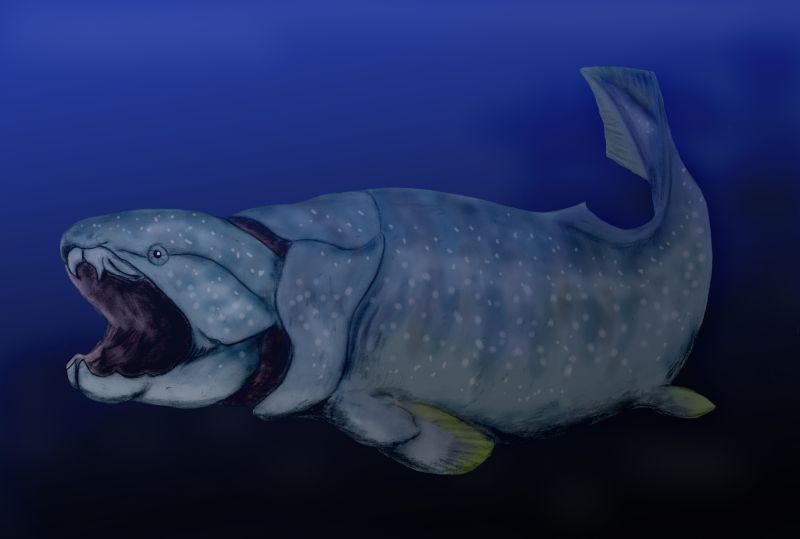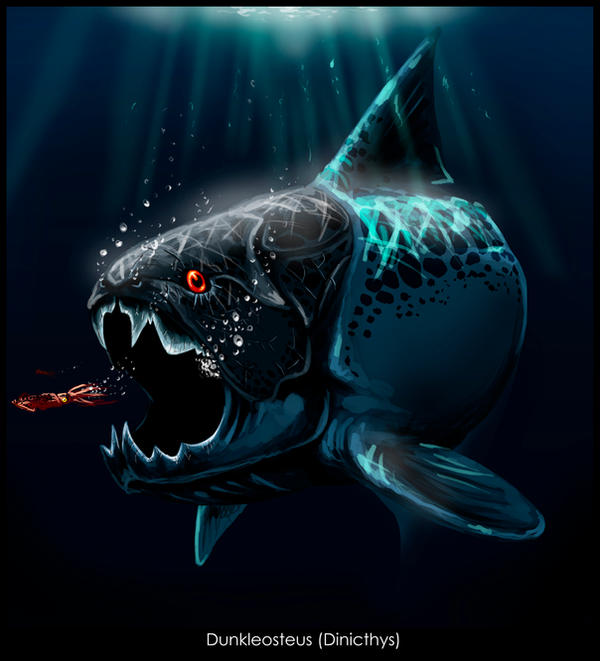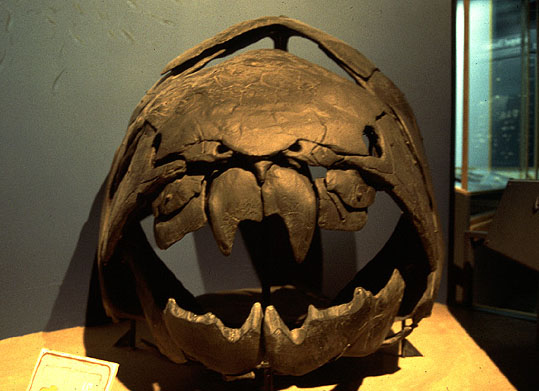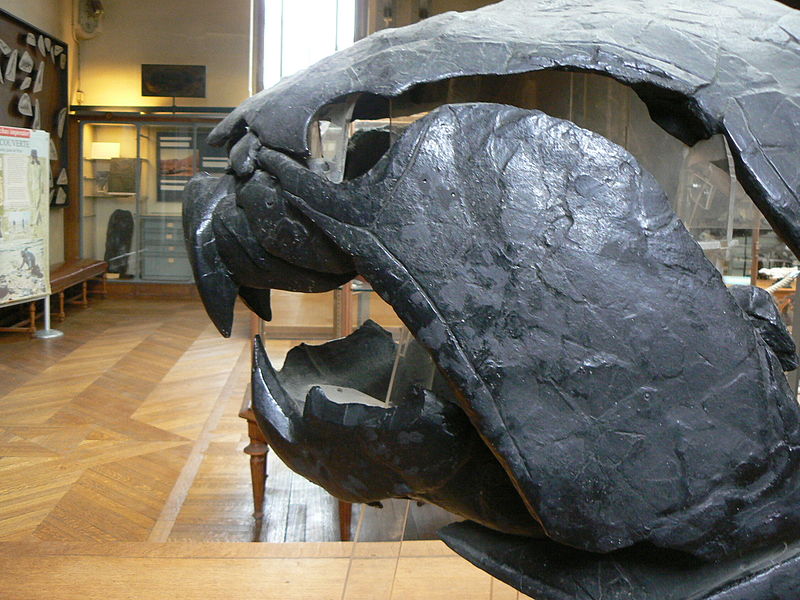[Recent Entries][Archive][Friends][User Info]
| September 25th, 2011 | ||||||||||
|---|---|---|---|---|---|---|---|---|---|---|
| 01:02 pm [industrialterro] [Link] |
Dunkleosteus Дунклеостей (Dunkleosteus) — род вымерших панцирных рыб класса плакодерм, живших в девонском периоде 415—360 млн лет назад. Его представители достигали 8—10 метров в длину и были крупнейшими морскими хищниками своего времени. Ископаемые останки обнаруживаются в Марокко, Бельгии, Польше и Северной Америке. Для девона Dunkleosteus имел достаточно развитые челюсти (хотя первые челюстные появились еще в силуре). Вместо зубов у него были большие костные пластины, полезные при раздроблении панциря других плакодерм. При изучении в Чикагском университете биомеханической компьютерной модели челюстей Dunkleosteus определили, что они могли развивать давление в 55 МПа, а это сопоставимо с укусом крокодилов. Более того, Dunkleosteus открывал рот за 1/50 секунды, в результате чего поток воды просто засасывал в него жертву. Останки Dunkleosteus часто обнаруживаются рядом с пережеванными костями. Предполагается, что он подобно остальным плакодермам отрыгивал те кости, которые не мог переварить. Due to its heavily armoured nature, Dunkleosteus was likely a relatively slow, but powerful, swimmer. It is thought to have dwelled in diverse zones of inshore waters. Fossilization tends to have preserved only the especially armoured frontal sections of specimens, and thus it is uncertain what exactly the hind sections of this ancient fish were like. As such, the reconstructions of the hindquarters are often based on smaller arthrodires, such as Coccosteus, that had hind sections preserved. The most famous specimens of Dunkleosteus are displayed at the Cleveland Museum of Natural History. Others are displayed at the American Museum of Natural History and in the Queensland Museum in Brisbane, Queensland. Instead of teeth, Dunkleosteus possessed two pairs of sharp bony plates which formed a beak-like structure. After studying a biomechanical model of the fish's jaws, scientists at the Field Museum of Natural History and the University of Chicago concluded that Dunkleosteus had the second most powerful bite of any fish (the giant Megalodon being the strongest). Dunkleosteus could concentrate a pressure of up to 8,000 pounds per square inch (55 MPa) at the tip of its mouth, placing Dunkleosteus in the same league as Tyrannosaurus rex and modern crocodiles as having the most powerful known bite. Dunkleosteus, like most other placoderms, may have also been among the first vertebrates to internalize egg fertilization, as seen in some modern sharks. Morphological studies done on the "jaw bones" (inferognathals) of juvenile and adult Dunkleosteus suggest that Dunkleosteus went through a change in jaw morphology and diet as it aged. Juveniles had stiffer jaws more similar to Coccosteus, and appear to have fed on various soft-bodied aquatic animals. The jaws of adults were more flexible to hold struggling prey, and were well equipped to bite through the bony armor of hard-bodied animals like other placoderms. There have been either three or four different species of Dunkleosteus described so far: D. terrelli This is the largest, best known species of the genus. It has a rounded snout. D. terrelli's fossil remains are found in Famennian Late Devonian strata of the eastern United States and Europe. D. marsaisi D. marsaisi refers to the Dunkleosteus fossils from the Famennian Late Devonian strata of the Atlas Mountains in Morocco. It is very similar in size and form to D. terrelli, differing only in the snout, which, in D. marsaisi, is more narrow. Many researchers and authorities consider it a synonym of D. terrelli. D. amblyodoratus D. amblyodoratus is known from some fragmentary remains from Late Devonian strata of Kettle Point, Canada. The species name means "blunt spear," and refers to the way the nuchal and paranuchal plates in the back of the head form the shape of a blunted spearhead. Although it is known only from fragments, it is estimated to have been about 20 feet long in life. D. raveri D. raveri is a small, possibly 1-metre-long species known from an uncrushed skull roof, found in a carbonate concretion from near the bottom of the Huron Shale, of the Famennian Ohio Shale strata. Besides its small size, it had comparatively large eyes. Because D. raveri was found in the strata directly below the strata where the remains of D. terrelli are found, it is suggested that D. raveri may have given rise to D. terrelli. The species name commemorates Clarence Raver of Wakeman, Ohio, U.S., who discovered the concretion the holotype was found in.
Репродукции (1, 2, 3, 4, 5, 6, 7, 8, 9, 10, 11, 12, 13):
Тут дунклеостеус преследует двух кладоселахий (длина акул - 1,2 метра):
Размеры в сравнении с человеком...
... и другими гигантами (ни фига не реалистично, особенно на фоне не в меру расползшегося ксифактина):
Ископаемые останки (1, 2, 3, 4, 5, 6, 7, 8, 9, 10, 11):
Tags: Вымершие рыбы, Девон, Плакодермы | |||||||||
| Comments | ||||||||||
Interesting articles keep posting more! tunnel rush | ||||||||||





























